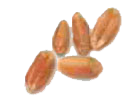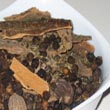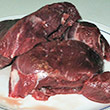Wheat
گندم
Wheat (Triticum spp.) is a grass that is cultivated worldwide. Wheat grain is a staple food used to make flour for leavened, flat and steamed breads; cookies, cakes, pasta, noodles and for fermentation to make beer, alcohol. The husk of the grain, separated when milling white flour, is bran. It is belongs to Poaceae family and genus Triticum.
اناج میں یہ سب سے زیادہ استعمال ہونے والا اناج گندم ہے۔ اس کی خوشبو بہت اچھی ہے۔ اسے سالم کی بجاۓ پیس کے زیادہ استعمال کیا جاتا ہے شائد کوئی گھر ایسا نہ ہو جہاں گندم کا استعمال نا ہوتا ہو۔
|
گندم ، گیہوں Common Wheat |
|
Common wheat is by far the most important wheat species in cultivation today. It belongs Poaceae family and genus Triticum. یہ Poaceae کی نوع Triticum سے تعلق رکھتی ہے۔ |
 |
Hard Red Spring
wheat berries : Hard, brownish, high protein wheat used for bread and hard baked goods. Bread Flour and high gluten flours are commonly made from hard red spring wheat. سال میں اس کی دو فصلیں (winter, spring) ہوتی ہیں۔ یہ پکنے میں بہت وقت لیتی ہے۔ |
|
Soft Red Winter wheat berries : Soft, low protein wheat used for cakes, pie crusts, biscuits, and muffins. Cake Flour, for example, is made from soft red winter wheat. |
 |
|
Hard White wheat berries : Hard, light colored, opaque, chalky, medium protein wheat planted in dry, temperate areas. Soft White wheat berries : Soft, light colored, very low protein wheat grown in temperate moist areas. Used for pie crusts and pastry. Pastry flour, for example, is sometimes made from soft white winter wheat. |
|
Durum wheat berries |
|
Itis the only tetraploid species of wheat widely cultivated today. Durum is the hardest of all wheats. Very hard, translucent, light colored grain used to make semolina flour for pasta. یہ Poaceae کی نوع Triticum سے تعلق رکھتی ہے۔ یہ وہ قسم ہے جس کے آٹے سے سویاں تیار کرتے ہیں۔ |
|
Einkorn wheat |
|
Einkorn wheat can refer either to the wild species of wheat, or to the domesticated form. Einkorn is a diploid species of hulled wheat, with tough glumes ('husk') that tightly enclose the grains. The cultivated form is similar to the wild, except that the ear stays intact when ripe and the seeds are larger. یہ Poaceae کی نوع Triticum سے تعلق رکھتی ہے۔ |
|
Emmer wheat |
|
It was one of the first crops domesticated in the Near East. It was widely cultivated in the ancient world, but is now a relict crop in mountainous regions of Europe and Asia یہ Poaceae کی نوع Triticum سے تعلق رکھتی ہے۔ |
|
QK-77 |
|
Its official cultivar name is QK-77, and it is a protected variety registered with the Plant Variety Protection Office of the USDA under Plant Variety Protection Certificate 8900108. مصر کے پرانے مقبروں سے چند گندم کے دانے ملے ، یہ فصل ان سے لی گئی ۔ یہ میٹھی خوشبو رکھتی ہے۔ اس میں پروٹین اورچیپ دار نائٹروجنی شے(gluten) زیادہ ہے۔ |
|
Rye flour has a lower gluten content than wheat flour, and contains a higher proportion of soluble fiber. t is closely related to barley and wheat. Rye grain is used for flour, rye bread, rye beer, some whiskies, some vodkas, and animal fodder. It can also be eaten whole, either as boiled rye berries, or by being rolled, similar to rolled oats. |
|
Spelt |
|
Spelt was an important wheat species in parts of Europe from the Bronze Age to medieval times. Spelt is sometimes considered a subspecies of the closely related species common wheat (T. aestivum), in which case its botanical name is considered to be Triticum aestivum subsp. spelta یہ Poaceae کی نوع Triticum سے تعلق رکھتی ہے۔ |
|
یہ تلخہ یا رئی اور گندم کی مخلوطُ الّنَسل ہے۔ اس میں پروٹین کافی ہوتی ہے۔ |
|
Bulgur (BUHL-guhr or BOOL-guhr) |
|
یہ سالم ملتے ہیں اور چھوٹے چھوٹے ٹکڑے کۓ ہوۓ بھی۔ انہیں بھگو کر بیک کیا ہوا ہوتا ہے اسی لۓ پکنے میں وقت کم لیتے ہیں۔ آپ خود بھی تیار کر سکتے ہیں ۔ ایک حصہ گندم دو حصے پانی میں ایک گھنٹہ ہلکی آنچ پر رہنے دیں پھر ان کو cookie sheet پر ڈال کر اوون میں 225° F ایک گھنٹہ رکھیں۔ سالم رکھیں یا انہیں باریک ٹکڑوں میں توڑ لیں۔ |
|
گندم کے ٹکڑے کر دیۓ جاتے ہیں یوں گندم سے جلدی پک جاتا ہے۔ |
|
The vast majority of today's flour consumption is wheat flour. All-purpose flour is a blended wheat flour with an intermediate gluten level which is marketed as an acceptable compromise for most household baking needs. Whole-wheat flour is whole-grain wheat flour. Whole grain flour is made from the entire grain including bran, endosperm, and germ. Bleached flour is flour that was subjected to flour bleaching agents in order to whiten it (freshly milled flour is yellowish) and give it more gluten-producing potential. Similar effect can be achieved by letting the flour slowly oxidize with oxygen in the air ("natural aging"); however this process is too slow to be commercially viable. Oxidizing agents are therefore employed, most commonly organic peroxides like acetone peroxide or benzoyl peroxide, nitrogen dioxide, or chlorine. Bromated flour is flour with a maturing agent added. The agent's role is to help with developing gluten, a role similar to the flour bleaching agents. Bromate is usually used. Other choices are phosphates, ascorbic acid, and malted barley. Bromated flour has been banned in some country. Cake flour is a finely milled flour made from soft wheat. It has very low gluten content, making it suitable for soft-textured cakes and cookies. The higher gluten content of other flours would make the cakes tough. Graham flour is a special type of whole-wheat flour. The endosperm is finely ground, as in white flour, while the bran and germ are coarsely ground. Graham flour is uncommon outside of the USA. It is the basis of true graham crackers. Many graham crackers on the market are actually imitation grahams because they do not contain graham flour or even whole-wheat flour. Pastry flour or cookie flour or cracker flour has slightly higher gluten content than cake flour, but lower than all-purpose flour. It is suitable for fine, light-textured pastries. Self-rising or self-raising flour is "white" wheat flour that is sold premixed with chemical leavening agents. It was invented by Henry Jones. Typical ratios are: U.S. customary: Metric: Durum flour is made of durum wheat. It has the highest protein content, and it is an important component of nearly all noodles and pastas. It is also commonly used to make Indian flatbreads. White flour is made from the endosperm only. A germ flour is made from the endosperm and germ, excluding the bran. |






